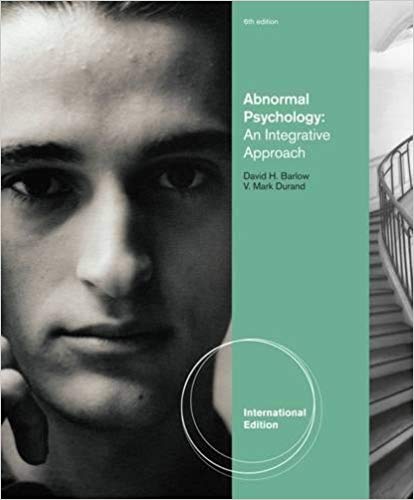Test Bank For Abnormal Psychology An Integrative Approach, 6th Edition International Edition by David Barlow
Digital item No Waiting Time Instant DownloadISBN-13: 978-1111343651 ISBN-10: 1111343659
In Stock
Original price was: $55.00.$24.00Current price is: $24.00.
Test Bank For Abnormal Psychology An Integrative Approach, 6th Edition International Edition by David Barlow
CHAPTER 2: CONCEPTUALIZING ABNORMAL PSYCHOLOGY
MULTIPLE CHOICE
1. The best description of the multidimensional integrative approach to understanding psychopathology is that it is based on
|
a. |
biological and psychological causes. |
|
b. |
biological causes only. |
|
c. |
learned helplessness and social learning theory. |
|
d. |
the physical structure and chemical processes of the brain. |
ANS: A DIF: Moderate OBJ: 1; APALO: 1.3.e
MSC:TYPE: Conceptual
2.Within the multidimensional integrative approach to understanding psychopathology, learned helplessness is considered a(n) ______ dimension.
|
a. |
biological |
|
b. |
psychological |
|
c. |
emotional |
|
d. |
psychological |
ANS: B DIF: Moderate OBJ: 1; APALO: 1.3.e
MSC:TYPE: Conceptual
3.The basis of the multidimensional integrative approach to understanding psychopathology is that each dimension (psychological, biological, emotional, etc.)
|
a. |
operates independently. |
|
b. |
is sufficient to cause pathology. |
|
c. |
builds on the dimension that precedes it. |
|
d. |
is influenced by the other dimensions. |
ANS: D DIF: Easy OBJ: 1; APALO: 1.3.e
MSC:TYPE: Conceptual
4.Your uncle spent most of his teen years in a hospital undergoing treatment for a severe physical illness. As an adult, he is rather shy and withdrawn, particularly around women. He has been diagnosed with social phobia, which you believe is entirely due to lack of socialization during his teen years. Your theory or model of what caused his phobia is ________.
|
a. |
multidimensional |
|
b. |
integrative |
|
c. |
one-dimensional |
|
d. |
biological |
ANS: C DIF: Easy OBJ: 1; APALO: 1.3.e
MSC:TYPE: Applied
5.According to the multidimensional integrative approach to psychopathology, the following statement is true for most psychological disorders:
|
a. |
If one monozygotic twin has a particular disorder, the other twin will definitely have the disorder as well |
|
b. |
Monozygotic twins are no more likely to share psychological disorders than any other siblings |
|
c. |
Monozygotic twins are no more likely to share disorders than any other two people selected at random from the population |
|
d. |
If one monozygotic twin has a particular psychological disorder, the other twin is more likely to have the disorder than the rest of the population |
ANS: D DIF: Moderate OBJ: 1; APALO: 1.3.e
MSC:TYPE: Applied
6.One of the problems with adopting a one-dimensional biological causal model of abnormality is
|
a. |
it ignores the contributions of psychological and sociocultural factors to the disorder. |
|
b. |
it ignores any interactions with other contributing factors. |
|
c. |
it ignores any environmental influences on the disorder. |
|
d. |
all of these |
ANS: D DIF: Easy OBJ: 1; APALO: 1.3.e
MSC:TYPE: Conceptual
7.Amanda is 12 years old, and her sister Samantha is five years old. While riding in a car with their parents, the girls witness a major automobile accident where a number of people are injured. The girls react very differently to the accident. This is probably due to
|
a. |
biological differences. |
|
b. |
developmental differences. |
|
c. |
psychological differences |
|
d. |
sociocultural differences |
ANS: B DIF: Moderate OBJ: 1; APALO: 1.2.a(4)
MSC:TYPE: Applied
8.The most accurate way to think of genes is that they
|
a. |
set boundaries for our development. |
|
b. |
determine both our physical and psychological characteristics. |
|
c. |
determine physical but not psychological characteristics. |
|
d. |
actually have very little to do with any of the characteristics that we display. |
ANS: A DIF: Moderate OBJ: 2; APALO: 1.2.a(3)
KEY:WWWMSC:TYPE: Factual
9.Referring to behavior and personality as polygenic means that both are
|
a. |
influenced by only a few genes, but each has a large effect. |
|
b. |
influenced by many genes, with each individual gene contributing a relatively small effect. |
|
c. |
influenced by individual genes only rarely. |
|
d. |
a result of our genetic structure only. |
ANS: B DIF: Moderate OBJ: 2; APALO: 1.2.a(3)
MSC:TYPE: Factual
10.The procedures referred to as quantitative genetics are used to
|
a. |
determine the effects of multiple genes. |
|
b. |
provide genetic counseling. |
|
c. |
correct genetic abnormalities. |
|
d. |
test the multidimensional integrative model. |
ANS: A DIF: Moderate OBJ: 2; APALO: 1.2.a(3)
MSC:TYPE: Factual


Reviews
There are no reviews yet.